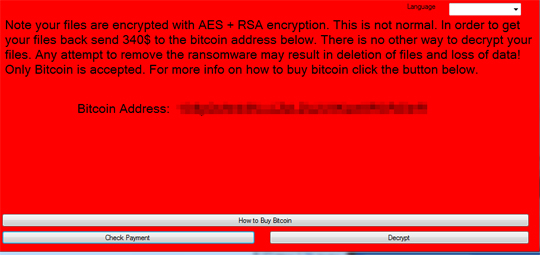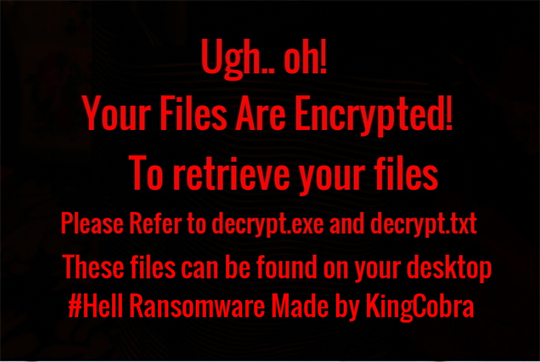RANSOM_RADIATION.A
Trojan-Ransom.Win32.Agent.izb (KASPERSKY); Trojan.Malcol.Ransom (NORTON); Trojan.GenericKD.5548406 (BITDEFENDER)
Windows


Threat Type: Ransomware
Destructiveness: No
Encrypted: No
In the wild: Yes
OVERVIEW
Dropped by other malware
This Ransomware arrives on a system as a file dropped by other malware or as a file downloaded unknowingly by users when visiting malicious sites.
It encrypts files with specific file extensions. It encrypts files found in specific folders. It drops files as ransom note.
TECHNICAL DETAILS
311,296 bytes
EXE
Yes
02 Jul 2017
Drops files, Steals information, Displays message/message boxes
Arrival Details
This Ransomware arrives on a system as a file dropped by other malware or as a file downloaded unknowingly by users when visiting malicious sites.
Installation
This Ransomware drops and executes the following files:
- %User Temp%\decrypter.exe - decryption form

Autostart Technique
This Ransomware adds the following registry entries to enable its automatic execution at every system startup:
HKEY_CURRENT_USER\Software\Microsoft\
Windows\CurrentVersion\Run
Microsoft Runtime = {Malware Path}\{Malware Name}.exe
Other System Modifications
This Ransomware changes the desktop wallpaper by modifying the following registry entries:
HKEY_CURRENT_USER\Control Panel\Desktop
Wallpaper = %User Temp%\memes.jpg
It sets the system's desktop wallpaper to the following image:
Dropping Routine
This Ransomware drops the following files:
- %User Temp%\memes.jpg - wallpaper
- {Malware Path}\RADIATION.bin - contains RSA key
- {Malware Path}\public.memes
- {Malware Path}\private.memes
- C:\autoexec.bat
(Note: %User Temp% is the user's temporary folder, where it usually is C:\Documents and Settings\{user name}\Local Settings\Temp on Windows 2000, Windows Server 2003, and Windows XP (32- and 64-bit); C:\Users\{user name}\AppData\Local\Temp on Windows Vista (32- and 64-bit), Windows 7 (32- and 64-bit), Windows 8 (32- and 64-bit), Windows 8.1 (32- and 64-bit), Windows Server 2008, and Windows Server 2012.)
Information Theft
This Ransomware attempts to steal stored email credentials from the following:
- %AppDataLocal%\Microsoft\Outlook\Outlook.pst
(Note: %AppDataLocal% is the Application Data folder found in Local Settings, where it is usually C:\Documents and Settings\{user name}\Local Settings\Application Data on Windows 2000, Windows Server 2003, and Windows XP (32- and 64-bit); C:\Users\{user name}\AppData\Local on Windows Vista (32- and 64-bit), Windows 7 (32- and 64-bit), Windows 8 (32- and 64-bit), Windows 8.1 (32- and 64-bit), Windows Server 2008, and Windows Server 2012.)
Ransomware Routine
This Ransomware encrypts files with the following extensions:
- .doc
- .docx
- .xls
- .xlsx
- .ppt
- .pptx
- .pst
- .ost
- .msg
- .eml
- .vsd
- .vsdx
- .txt
- .csv
- .rtf
- .123
- .wks
- .wk1
- .dwg
- .onet
- .oc2
- .snt
- .jpeg
- .jpg
- .docb
- .docm
- .dot
- .dotm
- .dotx
- .xlsm
- .xlsb
- .xlw
- .xlt
- .xlm
- .xlc
- .xltx
- .xltm
- .pptm
- .pot
- .pps
- .ppsm
- .ppsx
- .ppam
- .potx
- .potm
- .edb
- .hwp
- .602
- .sxi
- .sti
- .sldx
- .sldm
- .vdi
- .vmdk
- .vmx
- .gpg
- .aes
- .ARC
- .PAQ
- .bz2
- .tbk
- .bak
- .tar
- .tgz
- .gz
- .7z
- .rar
- .zip
- .backup
- .iso
- .vcd
- .bmp
- .png
- .gif
- .raw
- .cgm
- .tif
- .tiff
- .nef
- .psd
- .ai
- .svg
- .djvu
- .m4u
- .m3u
- .mid
- .wma
- .flv
- .3g2
- .mkv
- .3gp
- .mp4
- .mov
- .avi
- .asf
- .mpeg
- .vob
- .mpg
- .wmv
- .fla
- .swf
- .wav
- .mp3
- .sh
- .class
- .jar
- .java
- .rb
- .asp
- .php
- .jsp
- .brd
- .sch
- .dch
- .dip
- .pl
- .vb
- .vbs
- .ps1
- .bat
- .cmd
- .js
- .asm
- .h
- .pas
- .cpp
- .c
- .cs
- .suo
- .sln
- .ldf
- .mdf
- .ibd
- .myi
- .myd
- .frm
- .odb
- .dbf
- .db
- .mdb
- .accdb
- .sql
- .sqlitedb
- .sqlite3
- .asc
- .lay6
- .lay
- .mml
- .sxm
- .otg
- .odg
- .uop
- .std
- .sxd
- .otp
- .odp
- .wb2
- .slk
- .dif
- .stc
- .sxc
- .ots
- .ods
- .3dm
- .max
- .3ds
- .uot
- .stw
- .sxw
- .ott
- .odt
- .pem
- .p12
- .csr
- .crt
- .key
- .pfx
- .der
It encrypts files found in the following folders:
- C:\
It drops the following file(s) as ransom note:
- {Malware Path}\decrypt.txt

SOLUTION
9.850
13.512.02
04 Jul 2017
13.513.00
05 Jul 2017
Step 1
Before doing any scans, Windows XP, Windows Vista, and Windows 7 users must disable System Restore to allow full scanning of their computers.
Step 2
Note that not all files, folders, and registry keys and entries are installed on your computer during this malware's/spyware's/grayware's execution. This may be due to incomplete installation or other operating system conditions. If you do not find the same files/folders/registry information, please proceed to the next step.
Step 3
Restart in Safe Mode
Step 4
Delete this registry value
Important: Editing the Windows Registry incorrectly can lead to irreversible system malfunction. Please do this step only if you know how or you can ask assistance from your system administrator. Else, check this Microsoft article first before modifying your computer's registry.
- In HKEY_CURRENT_USER\Software\Microsoft\Windows\CurrentVersion\Run
- Microsoft Runtime = {Malware Path}\{Malware Name}.exe
- Microsoft Runtime = {Malware Path}\{Malware Name}.exe
Step 5
Search and delete this file
- %User Temp%\memes.jpg
- {Malware Path}\RADIATION.bin
- {Malware Path}\public.memes
- {Malware Path}\private.memes
- C:\autoexec.bat
- %User Temp%\decrypter.exe
- {Malware Path}\decrypt.txt
Step 6
Reset your Desktop properties
Step 7
Restart in normal mode and scan your computer with your Trend Micro product for files detected as RANSOM_RADIATION.A. If the detected files have already been cleaned, deleted, or quarantined by your Trend Micro product, no further step is required. You may opt to simply delete the quarantined files. Please check this Knowledge Base page for more information.
Step 8
Restore encrypted files from backup.
Did this description help? Tell us how we did.



